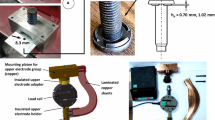Abstract
A fuzzy model was presented to predict the weldment shape profile of submerged arc welds (SAW) including the shape of heat affected zone (HAZ). The SAW bead-on-plates were welded by following a full factorial design matrix. The design matrix consisted of three levels of input welding process parameters. The welds were cross-sectioned and etched, and the zones were measured. A map** technique was used to measure the various segments of the weld zones. These mapped zones were used to build a fuzzy logic model. The membership functions of the fuzzy model were chosen for the accurate prediction of the weld zone. The fuzzy model was further tested for a set of test case data. The weld zone predicted by the fuzzy logic model was compared with the experimentally obtained shape profiles and close agreement between the two was noted. The map** technique developed for the weld zones and the fuzzy logic model can be used for on-line control of the SAW process. From the SAW fuzzy logic model an estimation of the fusion and HAZ can also be developed.
Similar content being viewed by others
References
Bandler W, Kohout LJ (1988). Special properties, closures and interiors of crisp and fuzzy relations. Fuzzy Sets and Systems, 26(3), 317–332.
Chan B, Chandel RS, Yang LJ, Bibly MJ (1994). Software system for anticipating the size and shape of submerged arc welds. Journal of Material Processing Technology, 40(3/4), 249–262.
Chandel RS, Bala S (1998). Relationship between submerged arc welding parameters and weld bead size. Schweissen Schneiden, 40(2), 28–31 (88–91).
Datta GL (2004). Metal-arc weld penetration capability-studies and analysis. Proceedings of National Seminar on Weld Integrity, Kolkata, 8–11.
Dhas JER, Kumanan S (2007). ANFIS for prediction of weld bead width in a submerged arc welding process. Journal of Scientific & Industrial Research, 66(5), 335–338.
Kim IS, Kwon WH, Siores E (1996). An investigation of a mathematical model for predicting weld bead geometry. Canadian Metallurgical Quarterly, 35(4), 385–392.
Kim SI, Son JS, Park CW, Kim IJ, Kim HH (2002). An investigation into an intelligent system for predicting bead geometry in GMA welding process. Journal of Materials Processing Technology, 159, 113–118.
Lee CS, Chandel RS, Seow HP (2010). Effect of welding parameters on the size of heat affected zone of submerged arc welding. Material and Manufacture Process, 15(5), 649–666.
Lee J, Um K (2000). A comparison in back-bead prediction of gas metal arc welding using multiple regression analysis and artificial neural networks. Optics and Laser in Engineering, 34, 149–158.
Mahapatra MM, Ali MS, Datta GL, Pradhan B (2005). Modelling and predicting the effects of process parameters on weldment characteristics in shielded metal arc welding. Indian Welding Journal, 38(2), 22–29.
Nagesh SD, Datta GL (2002). Prediction of weld bead geometry and penetration in shielded metal-arc welding using artificial neural networks. Journal of Materials Processing Technology, 123, 303–312.
Tanaka K, Sugeno M (1992). Stability analysis and design of fuzzy control systems. Fuzzy Sets and System, 45, 135–156.
Zadeh LA (1968). Fuzzy algorithms. Information & Control, 12, 94–102.
Author information
Authors and Affiliations
Corresponding author
Additional information
Foundation item: Supported by the IIT Roorkee Project under Grant No. FIG-A Scheme-A
Mr. H. K. Narang was born in 1983. He is currently working as a research scholar at Mechanical and Industrial Engineering Department of IIT Roorkee. His research topic is modeling the effects of open and covered arc welding process parameters on weldment characteristics and distortion.
Dr. M. M. Mahapatra was born in 1970. He is working as assistant professor of Mechanical and Industrial Engineering Department at Indian Institute of Technology, Roorkee. His current research interests include plate forming by line heating, welding deformation, welding residual stress analysis and designing of welded structures.
Dr. P. K. Jha was born in 1971. He is an assistant professor of IIT Roorkee, Dept. of Mechanical and Industrial Engineering. His area of expertise include process modeling, metal casting. He has, to his credit about 25 research publications in journals and conferences.
Dr. Pankaj Biswas was born in 1979. He is an assistant professor of IIT Guwahati, Dept. of Mechanical Engg. His current research interests include manufacturing and design: computational weld mechanics, ship production, line heating, FE structural analysis, etc.
Rights and permissions
About this article
Cite this article
Narang, H.K., Mahapatra, M.M., Jha, P.K. et al. Development of fuzzy logic system to predict the SAW weldment shape profiles. J. Marine. Sci. Appl. 11, 387–391 (2012). https://doi.org/10.1007/s11804-012-1147-9
Received:
Published:
Issue Date:
DOI: https://doi.org/10.1007/s11804-012-1147-9




